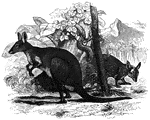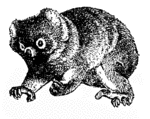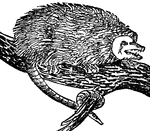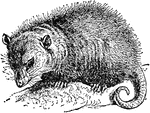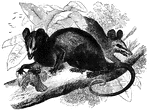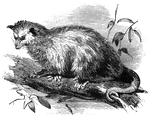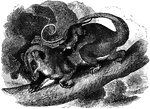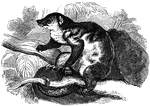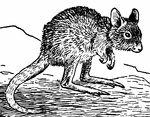Marsupials
The Marsupials ClipArt gallery contains 47 illustrations of this distinct division of mammals, best known for the pouch in which they carry their young through infancy.
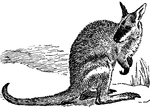
Agile Wallaby
The agile wallaby is a type of wallaby (or brush kangaroo). They are smaller than most kangaroos and…
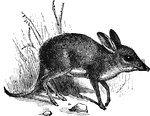
Bandicoot
Notable for the disproportionate development of hind limbs and the reduction of the lateral digits of…

Long Nosed Bandicoot
"Having a long head, with the upper part of the snout much prolonged: the tail is long and tapering;…

Bennett's Kangaroo
"Skull and teeth of Bennett's Kangaroo (Macropus bennettii). i1, i2, i3, first second and third upper…

Black Wallaby
The black wallaby is a type of wallaby (or brush kangaroo). They are smaller than most kangaroos and…
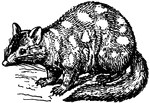
Dasyurus viverrinus
Dasyurus viverrinus, a small class of marsupial with a gray or brown coat spotted with white.

Banded Ant Eater
"It is about ten inches long, of a tawny color, marked with transverse bands of black and white. The…

Echidna Pelvis
"The pelvis of the Echidna; sa, sacrum; il, illum; is, ischium; p, pubis; m, marsupial bone." —…

Gray's Rat Kangaroo
"Skull and teeth of Gray's Rat Kangaroo (Bellongia grayii). c, upper canine tooth. i1, i2, i3, first,…

Infant Kangaroo
"Outline of the Kangaroo about twelve hours after birth, showing its natural size and external development…

Kangaroo
Kangaroos are found in Australia, New Guinea and Tasmania. They have powerful rear legs and a muscular…

Kangaroo
"The Kangaroo is an animal of Australia, first observed by a party of sailors on the coast of New South…
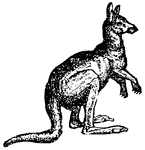
Kangaroo
Kangaroos are found in Australia, New Guinea and Tasmania. They have powerful rear legs and a muscular…

Giant Kangaroo
"It is of the size of a large sheep, and sometimes weighs one hundred and fourty pounds. The period…

Great Kangaroo
The Great Kangaroo, or 'boomer', or 'old man' (Macropus giganteus), attains a height of about five feet…
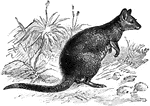
Papuan Kangaroo
They are small size and somber coloration, with the hair on the nape antrorse, the tail naked and scaly…
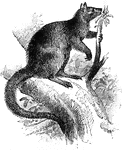
Tree Kangaroo
They are adapted for arboreal life, having the tail less robust tan that of the ground kangaroos, and…
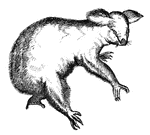
Koala
Koalas are marsupials, which means the females have a pouch of skin into which the very immature young…
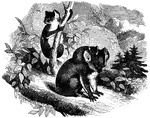
Koala
"Large as a moderate sized dog. It has long, thick and rather course fur, of an ashy-gray color; its…
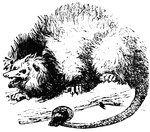
Opossum
The opossum is nocturnal and arboreal. At night it searches for insects, birds, eggs, fruit, etc. It…
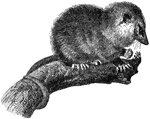
Opossum
"Opossum, of the marsupial family. Some species have pouches while others do not, and will therefore…
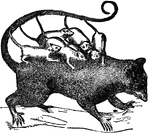
Opossum
A class of marsupial mammals native to America. They include a large number of species, ranging in size…

Opossum Mouse
"A genus or subgenus of marsupial quadreupeds of the family Phalangistdæ, peculiar to Australia."-Whitney,…

Common Opossum
"It has a pointed head, wide gape, numerous sharp teeth, a rough tounge, ears large and naked, small…

Water Opossom
"Opossom is the popular name for the pouched mammals which have a geographical range from the United…

Phalanger
"The Phalanger is a small woolly-coated marsupial, with opposable great toes, which are destitute of…

Potoroo Rat
"Is a mild, timid creature, of the size of a rabbit; the body is formed somewhat like that of a rat,…
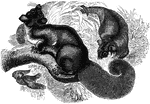
Sugar Squirrel
"It is about as large as our red squirrel; the tail rather longer than the body; the fur soft and beautiful;…

Tree Kangaroo
The tree kangaroo (Dendrolagus) is a species of a kangaroo. They are native to New Guinea and Queensland.
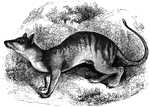
Tasmanian Wolf
"It is the size of a small wolf, with short, smooth, hair of dusky yellowish-brown color, barred on…

Wombat
An Australian marsupial, which somewhat resembles a small bear in appearance. The legs are short and…

Hairy Nosed Wombat
"The Wombat is a burrowing marsupial from Australia and Van Dieman's Land, and the islands of Bass'…


